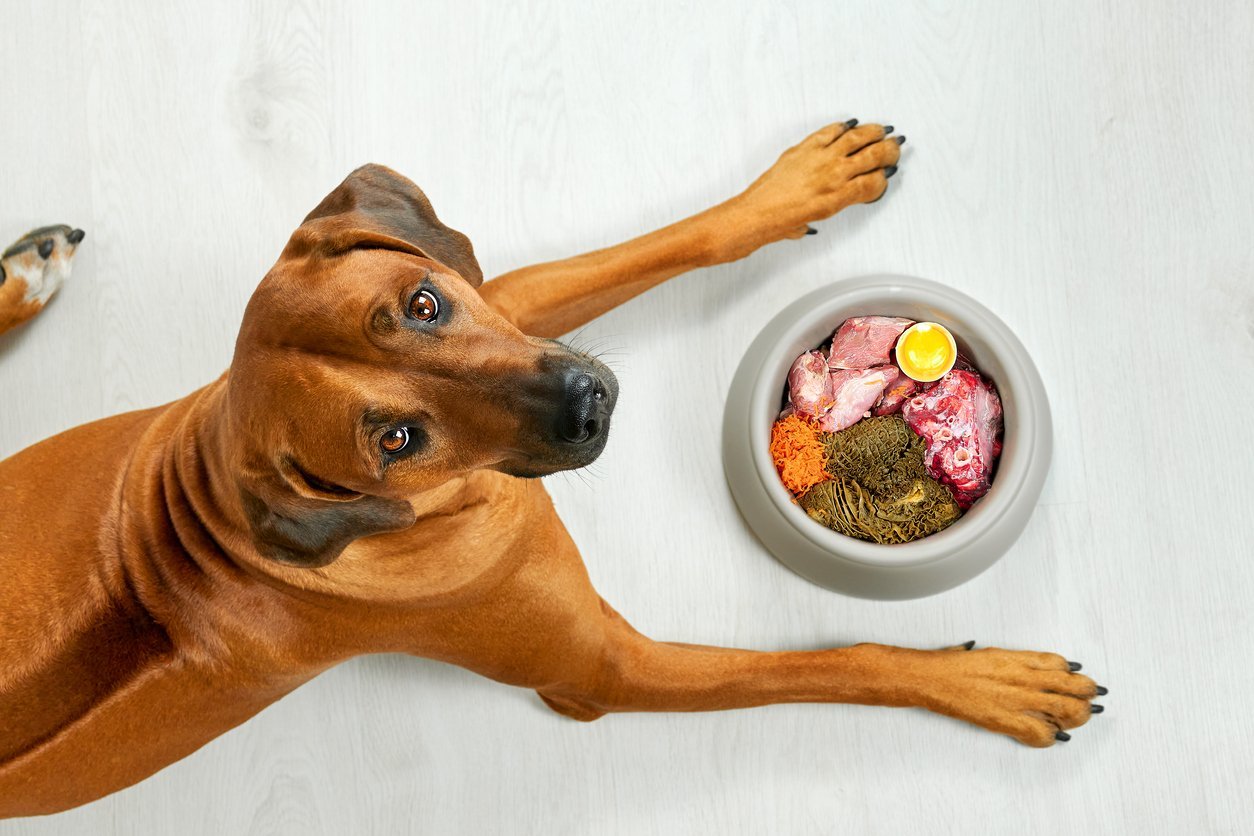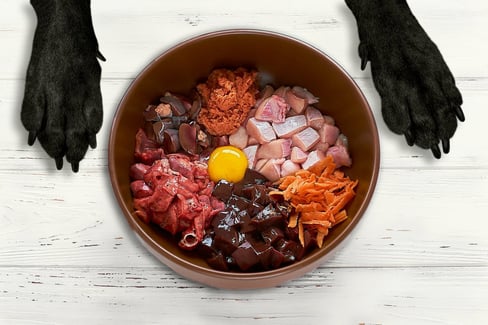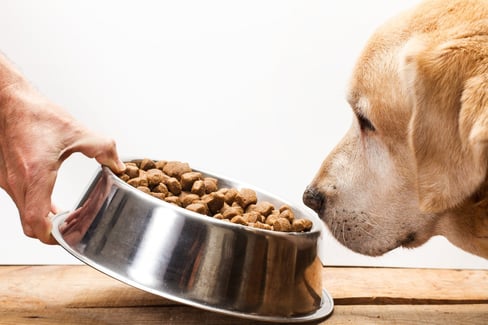Table of Contents
There’s always a new health craze we’re talking about — even for our pets! Just like any buzz-worthy diet for humans, you’ve probably heard of the raw dog food diet.
In fact, in a study completed in the US, researchers found that for 94% of consumers, a pet’s health is the number one factor when choosing what to feed their beloved furballs. Another interesting takeaway from the same study?
55% of those surveyed would rather give their pets a diet that can be served raw or home-cooked.
That’s over half of pet parents who want only the best for their pet—unsurprisingly, of course!
So if you’re wondering about the pros and cons of choosing raw dog food, what kind of ingredients go into a raw dog food diet, as well as what’s out there if you’re looking to buy packaged fresh, frozen, or freeze-dried raw dog food, this is the post for you.
We’ll also get into some of the alternatives to a raw food diet for dogs, and how you can ensure your dog is maximizing the raw dog food diet with supplements.
Without further ado, let’s get into a primer on raw dog food for beginners!
History of Raw Dog Food
Before we talk about the why and how of raw dog food for beginners, you might want to know where it originated from in the first place.
So let’s hop in the time machine and go back to a time when our canine pals weren’t domesticated quite yet.
To understand why raw food became so popular, we have to look to our pup’s ancestors. As much as they have always been our companions, as evidenced by the early wall paintings found in Egypt dating from c. 3500 BCE showing a human taking their collared and leashed dog for a walk, dogs were pretty wild for a lot of history as we know it!
Dogs hunted for prey carnivorously, and therefore would have eaten mostly raw meats, and whatever else they were able to hunt down.
As time passed, and humans increasingly domesticated them, dogs were still not being fed their own special kind of food. It was mostly scraps from the family dinner or what they could find during the day as they roamed around. As keeping pets became more socially acceptable, it became a sign of wealth and class status to care for a family dog. In fact, dogs of upper-class families would have been fed the original raw dog food diet with ingredients like fresh meats, whole grains, and vegetables.
As pet food commercialization happened at the turn of the 20th century, pet owners now had access to easy-to-purchase, manufactured products that were created. Unfortunately, they were often made with questionable ingredients, and even then, pet owners weren’t always so trusting of these commercial options, and for good reason.
Then, fast forward to 2001 when Dr. Ian Billinghurst used this historical knowledge to create the B.A.R.F Diet, also known as the Biologically Appropriate Raw Food Diet, or simply the raw dog food diet. He used the principles that our pup’s wild ancestors hunted and ate raw food for a robust, healthy diet and theorized that we should do the same for our pets today.
The Popularity of Raw Dog Food in North America

So now you know where it came from, but how did the raw dog food diet become so popular?
There were a few things that catapulted this diet to the centre of pet wellness discussions, including some human attitudes, as well as some not great things happening in the commercial pet food world.
The raw food diet really became popular after the sweeping 2007 pet food recalls. Pet parents wanted more control over their pets’ diets to prevent further tragedy, so, enter the raw food diet.
By cooking meals for your pets at home, you can control the ingredients, the sources of those ingredients, and how it’s prepared. This is where that element of human psychology comes in. We feel the need to reduce the pain and suffering for pets because we love them and they’re our family.
That, and as we become more aware of our own health and wellness, we also become more aware of how our dog’s diet impacts long-term health. Things like fillers, or chemicals we can hardly pronounce can be present in traditional dog food formats and that’s not always what we want to be feeding our dogs. Some have likened this to the idea that humans shouldn’t eat fast food every day, so why would we feed our dogs with only convenience foods?
So the raw food diet for dogs has skyrocketed into popularity for a variety of reasons, but one thing we should note is that no matter what research you’ve done, it is no substitute for advice from your veterinarian. Always consult your vet before starting a new diet, or supplement for your pet.
Is Freeze Dried Raw Dog Food Safe?
Freeze dried dog food is raw dog food with all its moisture sucked out through freezing temperatures and a multi-step drying process. The freeze-drying process allows food to be preserved for years. The bone-dry food can be plumped back up by adding water, making this a delicious and healthy way to make and store raw dog food.
Freeze dried raw dog food involves a three-step process:
- Freezing phase: Lowering the temperature until the liquid in the food becomes solid
- Primary drying/sublimation phase: Reducing pressure to reduce the water in the food
- Secondary drying/sublimation phases: Increasing the temperature to break the bonds between the water molecules and the food
To answer the question, “is freeze dried raw dog food safe”? Yes, it is. In fact, safer than an uncooked raw dog food diet.
Unlike fresh raw dog food, some freeze dried dog food goes through high-pressure processing (HPP), a pasteurization process used to decrease bacteria such as Listeria, Salmonella, and E. coli; this makes freeze dried dog food a great option for pet parents who want to provide their dog with the benefits of a raw dog food diet while reducing the risks of bacteria in uncooked food.
Freeze Dried Raw Dog Food vs Dehydrated Raw Dog Food
It is important to note the differences between freeze dried dog food vs dehydrated dog food. While the two types of raw dog food are often mistaken, there are differences in nutrition, texture, and rehydration.
|
Freeze Dried Raw Dog Food |
Dehydrated Raw Dog Food |
|
|
Freeze dried raw dog food maintains more nutritional value (97%) than dehydrated raw dog food (50-60%) , as the proteins, vitamins, and minerals stay intact due to freezing before drying.
Recommended Raw Dog Food Recipes
Getting started on a raw food diet for pets is easy. The most balanced raw food diet for dogs follows the ratios of the BARF diet: Biologically Appropriate Raw Food.
The ratios for the BARF diet are:
- 70% muscle meat
- 10% raw edible bone
- 5% liver
- 5% other secreting organs
- 7% vegetables
- 2% seeds or nuts
- 1% fruit.
Many recipes follow a flexible variation of these ratios, leaning towards only 10% of the caloric intake coming from plant sources.
We’ve gathered two raw dog food recipes you can try at home.
Raw Beef & Chicken Neck Raw Dog Food Recipe
If you have a young dog who you want to start with a raw dog food diet, this one is suitable for puppies. This one features chicken necks, a great source of calcium and protein known for their benefit to canine dental health. Chicken necks are also packed with glucosamine and chondroitin, the most important ingredients for joint health.
The key ingredients of the recipe are:
- 3 pounds of chicken necks with the skin removed
- 2 pounds of lean beef
- 1 pound beef liver
- 1 pound chicken heart
- 1 pound beef heart
- 10 pasture-raised eggs without shells
- 8 ounces kale
- 8 ounces broccoli
- 12 ounces of mixed berries
You can view the complete recipe on Dogs Naturally Magazine.
Beef and Chicken Liver Raw Dog Food Recipe
Livers are another nutritious part of the chicken that can be fed to dogs raw, chicken livers are high in vitamins such as vitamin B12 and A. However, chicken liver should be fed to dogs sparingly as a treat, approximately once a week. This recipe is great for dogs of all ages and can be modified to suit your pup’s age and dietary needs.
The key ingredients of the recipe are:
- 2 1/2 pounds ground beef
- 4 ounces chicken livers
- 1 carrot, chopped
- 1 small apple, cored
- 1/2 cup baby spinach
- 2 whole eggs (including shell)
- 1/2 cup plain yogurt
- 1 tablespoon ground flaxseed
- 1 tablespoon olive oil
You can view the complete recipe on Running to the Kitchen.
Raw Dog Food Pros and Cons

As with anything, there are definitely upsides and downsides to a raw dog food diet.
And sometimes, you need to see past the fluff and get to the bark, or should I say, heart, of the matter.
Thankfully, we’re here to break down the raw dog food pros and cons, so lets paws and reflect on them before getting into the rest of the post.
Pros of Raw Dog Food
First up, let’s talk about some of the benefits of the raw dog food diet for beginners.
There are definitely some serious pros to this diet, so let’s dive into them:
- Address Specific Needs of the Dog: The raw food diet allows you to customize the recipe you’re feeding your pup, and leave out the things that seem to bug their tummies most. That, and you can add in specific ingredients targeted at helping soothe a certain ailment. For example, many dieticians say cooked sweet potatoes are great sources of dietary fibre which can be good at reducing the risk for heart disease and certain cancers.
- Control Quality: Since you’re the one making your dog’s dinner, you can control where the food comes from, how it is prepared, and what kind of quality of meat they get to chow down on. You can go to your local butcher and grab the finest cut of beef available, or you can make sure your beloved furry family member only gets the highest quality local vegetables mixed into their meal. Many pet owners like this aspect most when choosing a raw food diet.
- Avoid Commercial Pet Food Recalls: Melamine for dinner? No thanks! Pet owners who opt for a raw food diet for their dogs don’t have to worry about watching for recalls on pet food brands. As we said, you’re the one choosing the ingredients that go into your canine companion’s food, so you don’t have to look into the bag of kibble with the dread of wondering, “what’s actually in there?”.
- Health Benefits of Raw Dog Food: Many dieticians, pet parents, and some vets have touted the benefits of this diet. From offering a shinier coat to easing digestive woes to a stronger immune system, there are a ton of potential benefits to your dog’s health by choosing a raw food diet. Some owners have even shared how their dog has benefitted from a raw food diet to curb allergies to some of the less savoury ingredients found in dry food. Of course, if you have a fat dog who needs a lower-calorie diet, you can choose raw lean meat and vegetables over higher-calorie ingredients.
- Can Prep Ahead: Who doesn’t love meal prep?! While it may not feel like the most fun thing to do, meal prepping can make your (and your pup’s) life easier. Since raw food can be frozen and stored for a few weeks to a few months at a time, it’s a handy way to make sure your pup is getting whole nutrition, and consistently.
Cons of Raw Dog Food
So as you can see, some pup owners really see the difference between feeding raw food and regular, commercial dog food.
While it is great that so many people are able to see improvements in their dog through a raw food diet, there are some drawbacks to consider as well.
Let’s run down the list of some of the more negative aspects of the raw food diet for dogs:
- Time Consuming: The raw food diet is definitely not the same as running to the grocery store to grab a bag or tin of food. You will have to do everything from source the ingredients, prepare your dog’s food (hopefully you own a meat grinder), mix up and store the raw dog food appropriately to avoid you, your dog, or your family getting sick (more on that next). So needless to say, if you’re already a busy pet parent, this may not be the diet for you.
- Not For All Dogs: Some pets with chronic diseases like pancreatitis and cancer have special nutritional needs, and though they may not have had trouble in the past with raw dog food, cooked food is often best in these cases. Consult your veterinarian if you’d like to opt for a special raw food diet for your dog, but it will likely not be the best option for your canine. The raw dog food diet isn’t always a great choice when you wonder what to feed a sick dog with no appetite.
- Can Be Difficult to Balance Nutrients: Puppies and seniors both have complex nutritional needs, making these age groups the least ideal candidates for a raw dog food diet. Since it’s likely that your tools are limited to that of a home kitchen, it’s not as easy to ensure you are getting everything your dog needs into the food as it is for vets or doggie dieticians in a commercial manufacturing setting who can measure and test food at a more molecular level.
- Meticulous care is required: Remember how we said there’s potential for you and your family to get sick when preparing this kind of diet? The risk of getting a foodborne illness from preparing raw food for dogs is unfortunately one of the biggest drawbacks of a raw diet. Ensuring safe handling of all meats and the food itself, plus proper freezing and thawing procedures, as well as a thorough cleaning of the kitchen and surfaces afterward, is really important to make sure your family doesn’t get sick from the food you’re making for your pet.
The bottom line? If you follow the right advice from your vet and ensure you’re being as safe as possible while handling raw pet food, then a raw diet could be a great choice for your dog.
Recommended Raw Dog Food Ingredients
Now that we’ve covered the basics, you might be wondering what exactly you’re supposed to be choosing for your dog on your next trip to the grocery store.
Before we get any further, we wanted to note that while we certainly have done our research, it’s important to keep in mind that we’re not vets or pet nutritionists. Always consult with your vet to talk about specific needs your dog may have, or health concerns unique to them.
1. Organ Meat
One of the primary components of a raw dog food diet? Organ meat! While liver may not be at the top of the list of what you’re ordering when you go out for dinner, not only do pets like the taste but organ meat is packed with vitamin A, B1, B2, B6, folic acid, vitamin B12 plus minerals including iron and magnesium. Talk about a powerful ingredient.
2. Raw Muscle Meat
If you’re new to raw food for dogs, you’re going to need to find a high-quality source of your pup’s protein since this is one of the biggest components of the diet. Also, make sure the protein you choose is suitable for your particular dog. Dogs can typically eat chicken, lamb, beef, and turkey with no issues, however, it’s important to check with your vet to make sure your dog isn’t allergic or sensitive to these meats. It’s generally a good idea to avoid processed meats like hot dogs, bologna, or sausage.
3. Bones
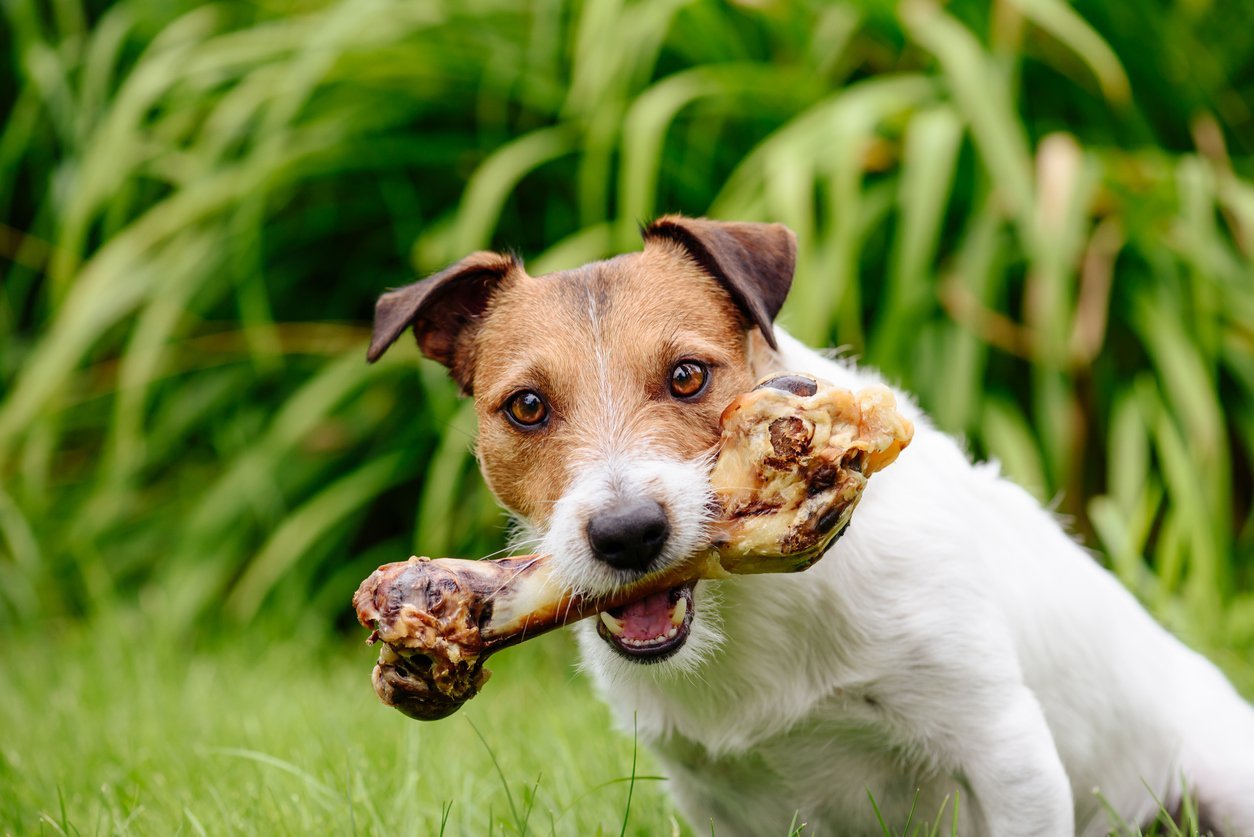
Bones are packed with calcium, perfect for keeping your furry friend’s bone health in check. But be careful! Chicken bones are hollow and can splinter easily, making for a nasty choking hazard. Bones do offer a host of benefits including offering a variety of minerals and helping prevent plaque build-up, however, you must be VERY careful when working them into their diets. If you choose to add them to food, they should be ground down using a meat grinder to avoid choking, GI tract trouble, and broken teeth.
If you want to give your pup something to chew on, there are lots of options to choose from. Just make sure the bone you’re selecting is about the size of their head, and if they’re new to chewing, only do it in short intervals so they can get used to the extra fats. Also, never leave a dog unsupervised when they’re chewing a bone just in case.
4. Dog-Safe Fruit and Vegetables
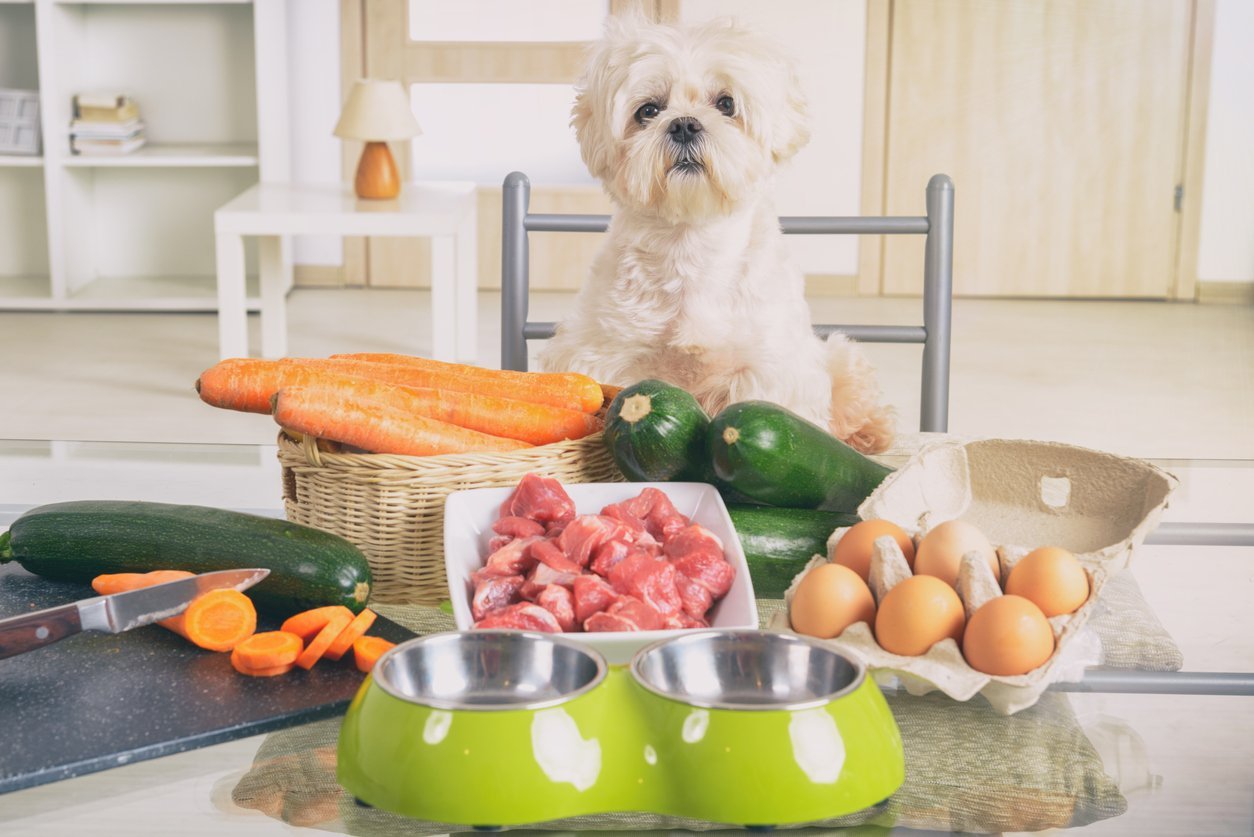
The last category of ingredients most commonly used in a raw food diet for dogs is fruits and vegetables.
These can be a great addition to a recipe for raw dog food, and offer a host of benefits to your pup, too. However, be careful not to add in a fruit or vegetable that your pup can’t digest properly or that will make them sick. For example, pumpkin is a great source of vitamins A, C, and E plus potassium and iron and will make your pet’s digestion easy. Onions on the other hand? Those are toxic to your dog. So consult the table below and talk to your vet of course before you get started with raw food for dogs:
| Raw Dog Food Ingredient | Is it safe for dogs? |
| Brussels Sprouts | Yes |
| Carrots | Yes |
| Avocados | No |
| Cherries | No |
| Pumpkin | Yes |
| Asparagus | No |
| Sweet Potato | Yes |
| Bananas | Yes |
| Tomato | No |
| Blueberries | Yes |
| Cucumbers | Yes |
| Onions/Leeks/Chives | No |
Our Recommendations for Packaged Raw Dog Food Canada
You’re probably wondering, now that you know the basics of raw dog food for beginners, how you can make it easier to implement raw dog food into your pup’s diet. After all, this diet can be so great, but trying out raw dog food for beginners can end up taking a ton of time out of your busy life.
The good news is that there are convenient options out there if you’re just starting out on your raw dog food journey!
But the number of options out there can be mind-beagle-ing, so let’s break down the best raw dog food Canada has to offer pet parents.
Best Fresh Packaged Raw Dog Food: FreshPet

If you’re looking for the closest thing to homemade raw dog food, then FreshPet is it!
This brand offers a variety of products, but their fresh raw dog food is perfect for those looking for the easy answer to raw dog food for beginners, because the simple slice and serve packaging takes about a minute from the fridge to the doggie dish. Talk about raw food with ease!
Price $17.49 CAD as of May 2023.
Best Freeze-Dried Raw Dog Food: Open Farm
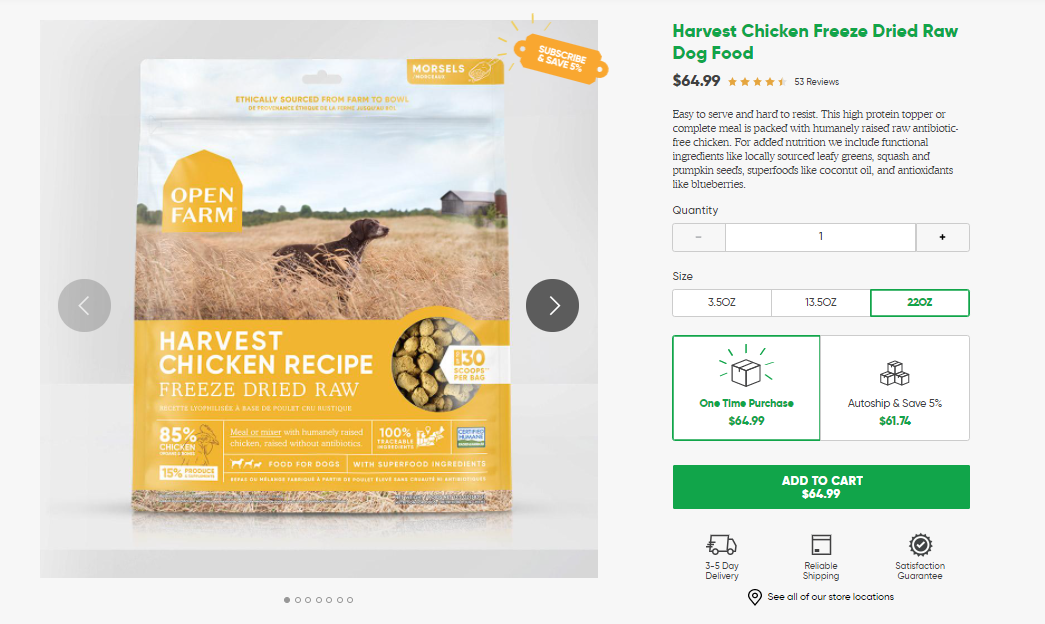
Our pick for best freeze-dried raw dog food has to go to Open Farm.
Most products come with 3 size options to choose from so you don’t have to worry about buying too much before ensuring your pup likes their new raw dog food.
Price $12.99 - $64.99 CAD as of May 2023.
Best Frozen Raw Dog Food: Instinct
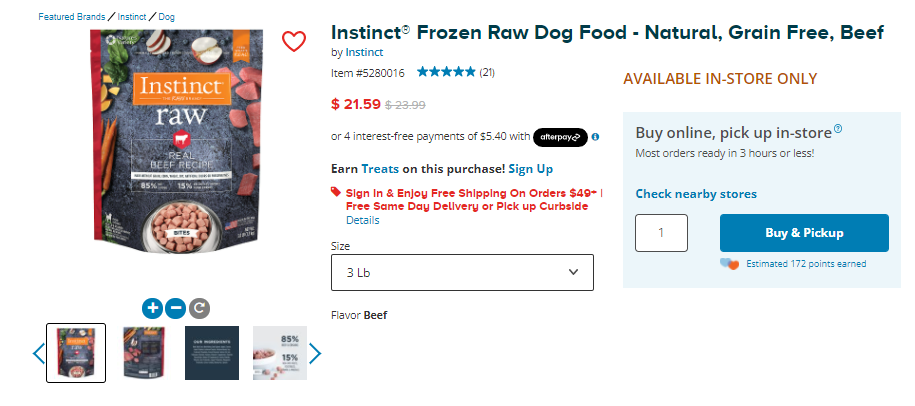
Instinct is a wide-ranging line of pet foods perfect as raw dog food for beginners. Offering everything from patties of frozen raw food, to small, digestible morsels, this is able to be stored in the freezer for long periods of time and easily be served up to your pup when it’s mealtime.
Price $29.99 - $49 CAD.99 as of May 2023.
Best Subscription Raw Dog Food: Nutricanine
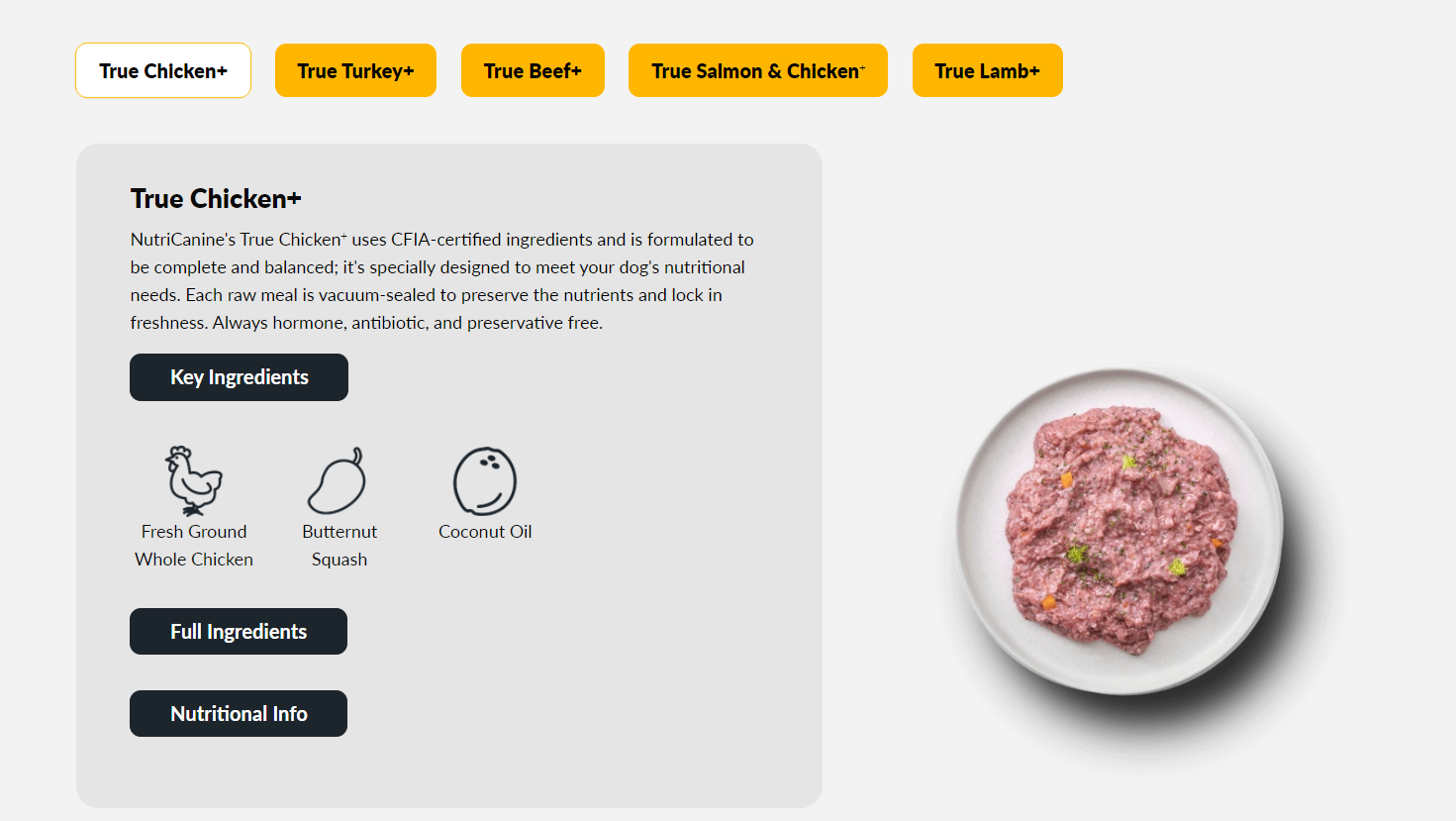
Nutricanine is a subscription-based service that creates a custom plan for your dog based on their age, weight, activity level, and breed. This is perfect for those pet parents who want something special for their pet, but don’t have time to invest in making those meals themselves. This conveniently gets delivered to your door, but it comes at a price, so be prepared to pay for this service if it’s something you’re interested in.
Pricing varies per subscription.
Best Dehydrated Raw Dog Food: Stella & Chewy’s
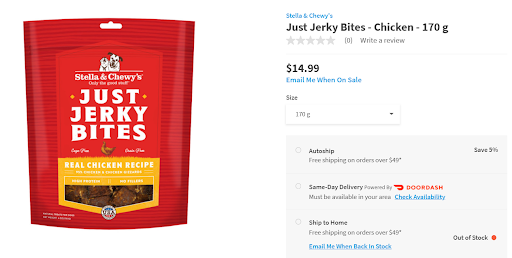
This brand has a ton of offerings, but specifically has great dehydrated raw dog food offerings like these tasty treats your dog will gobble up.
Price $15 CAD.99 as of May 2023.
Alternatives & Additions to Raw Dog Food
So raw dog food has its ups and downs, as well as some great commercially available options too, but what if that’s just not for you or your pet?
Don’t worry! We’re breaking down the best alternative options to raw dog food next, so you can make sure your pup has the type of food that works best for them.
Kibble
First on the list is kibble. This format of dog food is one of the most popular for good reason. It offers a host of great benefits, like:
- It’s economical.
- It’s convenient.
- It lasts a long time.
- Good for dental health because the chewing of hard kibble bits knocks plaque loose.
- Can find a specific formulation that suits your pet’s needs (senior, puppy, coat/skin)
Now that’s not to say kibble has no drawbacks. Just make sure you read the ingredients carefully! There could be a bunch of unnecessary fillers in there that don’t benefit your pet at all.
There are even raw hybrid options now available, like Open Farm's RawMix for Dogs containing nutrient-dense kibble coated in bone broth with freeze-dried raw blend.
Freeze-Dried Food
On to the next alternative to raw dog food on our list, freeze-dried food. Freeze-dried food is dog food that has been processed using freezing to remove its moisture at very cold temperatures. It’s just as convenient as kibble, but it has more usable nutrients for your dog.
Plus, the nutrients are more high quality, and they remain intact due to the freezing process. The only drawback is that it can be expensive, but it’s the high quality you’re paying for.
Wet Food for Dogs
Also known as canned, wet food for dogs comes in next on the list of alternatives. It’s easy to find at the grocery store and offers you long shelf life. There are plenty of palatable, tasty options your dog will love, too.
If you’re not in love with the idea that your pup is eating out of a can or are nervous it won’t be as beneficial, you can now get gourmet wet food for dogs that come pre-packaged and ready to dish up in plastic dishes instead of cans. But be careful of artificial colours and flavours, as well as not all wet food is created equally.
Pet Supplements
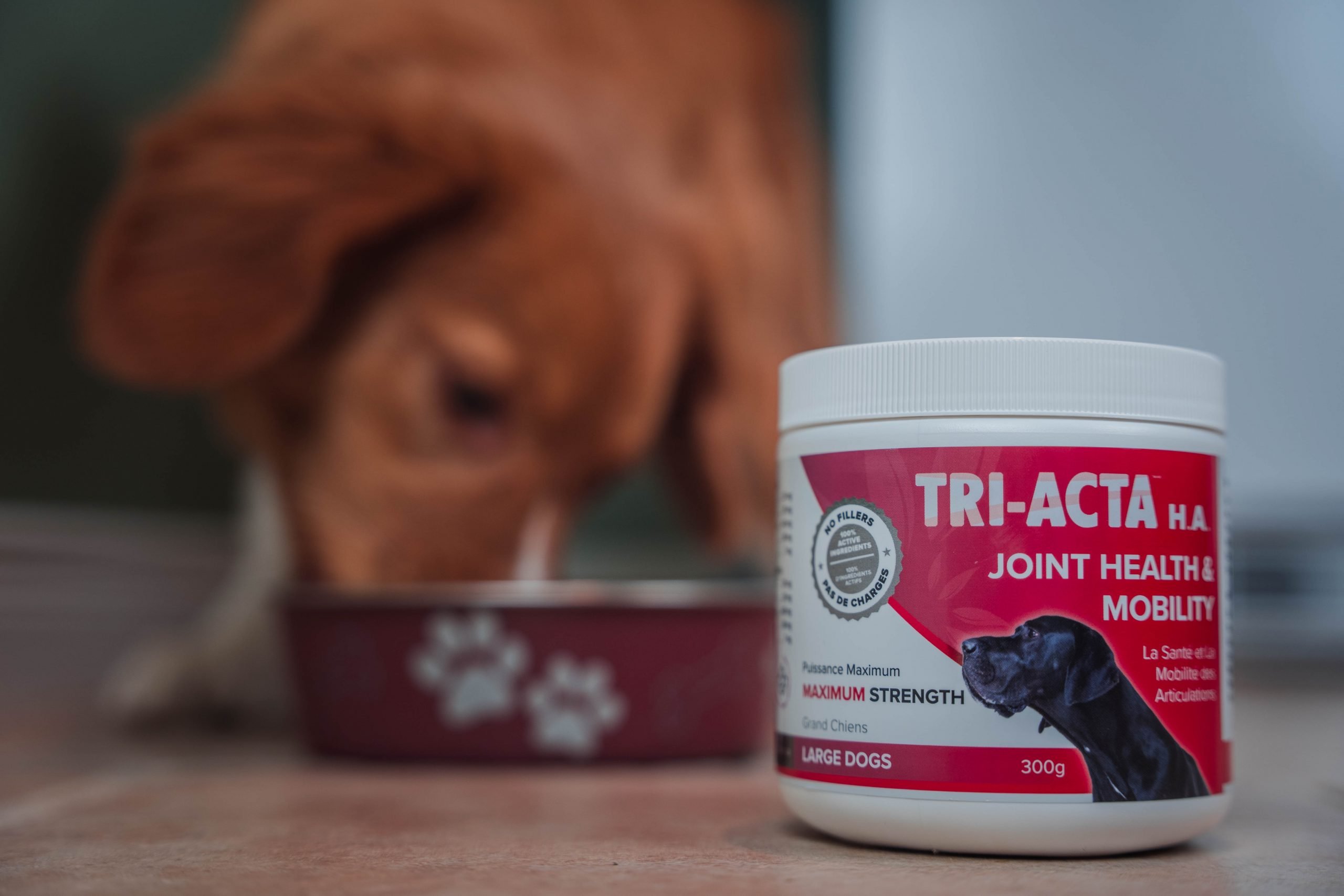
Finally, if you’ve been searching for raw dog food for beginners, you’re probably wanting a diet for your dog that helps give them the maximum nutritional benefits possible.
One way to transition your dog or to try a specialty diet like the raw food diet is to add pet supplements to their diet.
Both offer the ability to ‘fill in the gaps in raw dog food diets and prevent other diseases and health issues from coming up in the future.
Plus, if your furry friend has been showing some signs of trouble in a specific department, like displaying signs of dog arthritis, prevention is key. If it’s already a chronic issue, there are also options out there that treat these issues, as this maximum strength formula.
TRI-ACTA H.A. for Pets
Our maximum strength formula is optimally designed to accelerate the formation of cartilage, minimize inflammation, expedite the healing process, and improve joint conditions.
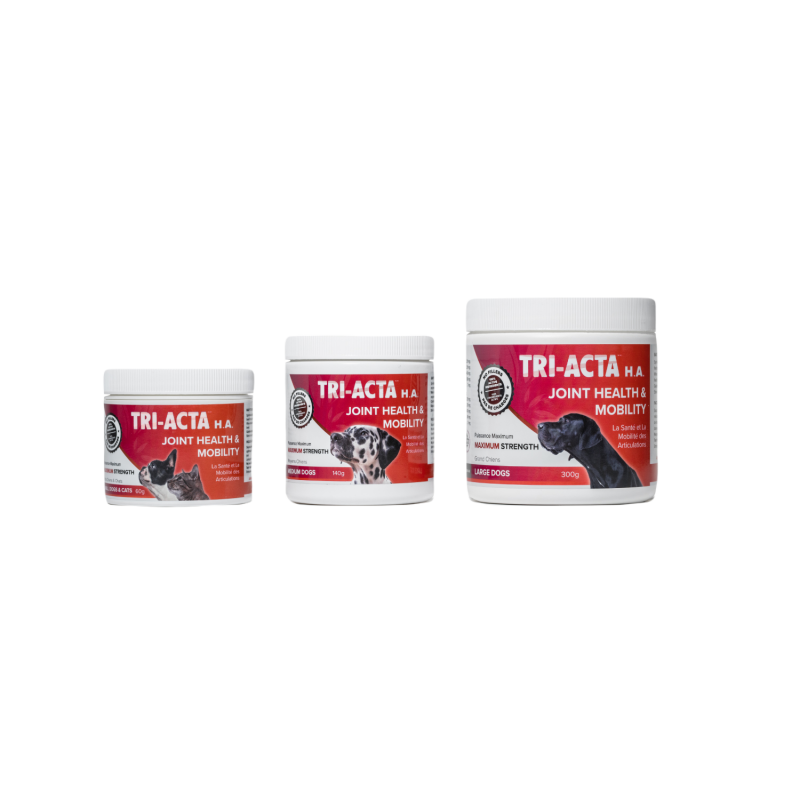
How Dog Supplements Help Maximize Benefits
So now you have the pawsome details on a raw dog food diet, let’s talk about how you can make that diet most successful for your dog.
Ensuring their diet is filled with the right nutrients is so important for a healthy and happy pup, but what exactly does that look like?
While you’ll have an easy time checking some of those nutrients off the list by simply preparing your raw dog food, others are more tricky and even challenging to get from your DIY diet.
Supplements for dogs!
Supplements for your dog can help maximize the benefits of a raw dog food diet, so let’s go over some of the most popular types of supplements for dogs out there.
Popular Types of Dog Food Supplements
If you’re hoping to find a supplement that works for your pet, your first stop should be your vet.
But if you’re wondering what is out there, we’re going to break down the most pupular types of supplements in the following table:
| Supplement Type | Key Ingredient/Formula | Benefits |
| Dental Health | Typically chew treats or pastes have both natural flavours like spearmint or green tea, and a chewy texture to mechanically reduce plaque, as well as agents to chemically reduce plaque e.g. sodium tripolyphosphate. |
|
| Digestion Support | Prebiotics like Inulin. |
|
| Skin/Coat Supplements | Sources of Omega Fatty Acids, like:
|
|
| Joint Health Supplements |
|
|
| Immune Support Supplements |
|
|
Frequently Asked Questions (FAQ)

With all that information coming your way, you’re bound to have some questions, so let us answer the most common questions those raw dog food for beginners might have.
How to Use a Raw Dog Food Calculator?
Online, you will find many calculators to help you understand how much raw food to feed your dog. Typically, these calculators will ask you:
- Your dog’s age
- Your dog’s breed
- How active is your dog?
- How much does your dog weigh?
Then, using the information you enter, it will tell you how much raw dog food per day your pup should be getting.
What’s Dehydrated Raw Dog Food?
Dehydrated raw dog food is a dried dog food that helps dogs get the benefits of the raw dog food diet without some of the safety risks. The process of making dehydrated raw dog food is when you cook, for example, meat at low temperatures to eliminate the moisture without losing nutrients along the way. This makes it a tasty snack for your pup that will be shelf-stable for many months.
Start Preventing Dog Joint Problems Now
So that’s it!
All you need to know about raw dog food for beginners, from what it is, what should be included in a raw dog food diet, as well as some of the commercially available raw dog food options out there today. We also reviewed some of the pros and cons of a raw dog food diet and talked about alternatives to this specialty diet.
The two biggest things we’d hope you take away after reading this post are:
- Always consult your veterinarian no matter what kind of diet you’re pursuing for your pet.
- Dog supplements can help support your dog’s diet and ease specific concerns, and protect them from future illnesses like arthritis.
If supplements are on your shopping list, specifically joint health supplements, then Integricare TRI-ACTA and TRI-ACTA H.A. should be your first choice.
With no fillers, 100% active ingredients, and two forms of glucosamine for dogs, plus the addition of hyaluronic acid in our maximum strength formula is the perfect choice for dog owners hoping to keep their pups healthy and spry for years to come.
If you have questions about TRI-ACTA and TRI-ACTA H.A., you can always contact us, and we’ll answer your questions as best we can.
TRI-ACTA for Pets
A proactive approach for developing and younger adult pets to maintain optimal joint health mobility, minimize inflammation and fend off age-related ailments.

Newsletter Signup
Subscribe to our newsletter to receive the latest news and exclusive offers.
.jpg?height=2000&name=Cliick_Integricare-DISPLAY-REVISEDV2%20(1).jpg)
Proactive & Therapeutic Joint Supplements
When given daily, Integricare joint supplements recover bone and joint injuries faster and help prevent mobility injuries from happening in the first place.

